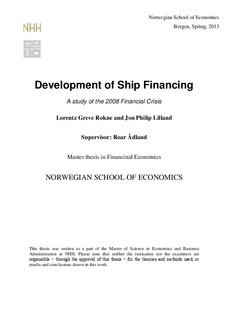| dc.description.abstract | This thesis looks to examine the period before and after the financial crisis of 2008 in order to identify any potential shifts in ship financing. For our period of analysis, we defined the pre period from the start of 2005 until the end of august 2008, while the post period is defined as the period from September 2008 until the end of 2012. In our empirical analysis we have used inferential statistics to test our predictions. The data used have been gathered from two world-renowned shipping information providers, Clarksons and Marine Money. By pooling and later segmenting the provided data, we have created our own database, tailored for our research questions.
Our analysis shows that there has indeed been a shift from the traditional financing source of bank loans towards corporate bonds. By the end of 2012, bond issuance stood for almost 45% of ship financing, up 40% from the start of the sample. Such a shift also involved a change in location of funding, with Asia and Scandinavia providing significantly greater number of debt issuances in the aftermath of the financial crisis, while North America, Europe and the Middle East experienced a deterioration of their funding proportions. In addition, the use of public equity markets as means of financing has greatly declined, resulting in a greater reliance on debt in the post period.
Given the increased importance of bonds, the authors have also examined this instrument in more detail. Our findings show that bondholders demand higher return and are less willing to engage in long-term commitments in the post period, as a result of the greater market uncertainty. Such an uncertainty has also caused banks to alter their lending practice, with a greater focus on risk mitigation.
Our takeaway from our analysis is quite extreme, with a severe change in ship financing over the last eight years. Looking into the future, we do believe that the ship financing picture has changed permanently, but in a less radical way than what we have observed in our sample. We expect bonds to take a larger part in ship financing, nevertheless, we still expect bank loans to be the primary source of capital. | no_NO |
